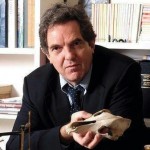We interviewed Professor Enrico Alleva, ethologist Director of the Department of Cell Biology and Neuroscience at the Italian Institute of Health and President of the Italian Federation of Natural and Environmental Sciences.
Insects as food for humans has been recently discussed in our country, it has become a matter of discussion and serious thoughts –about market too- that suggests a strong growth in the near future.
If it was possible to breed edible insects for human consumption in Italy, which particular health and hygiene problems entrepreneurs and consumers might have to face? Or might this problems be compared to those of meat consumption?
Quite recent, infact in the last few years we are discussing on entomophagy and edible insects in scientific and institutional contest, although the echoes became public more recently, largely thanks to Expo.
Health and hygiene critical issues are obviously different depending on reared species. As well as vertebrates, edible insects can be carriers of infections too, especially if bred in large numbers. Besides, traditional livestock farms are place of infections, controlled and eradicated with very high costs for the National Health Service. For instance, we all remember the “aviaria” flu and the “mad cow” virus.
In insects breeding the greatest risk could be environmental rather than sanitary. Foreign species grown for food may lead to phenomena of infestation by alien species, which could cause damages and potential problems for their eradication. But to avoid this risk a careful monitoring and adequate containment systems will be sufficient.
Another problem may relate to safety in the breeding of dangerous species, such as scorpions.
The great interest for Italian food world is also based on the attention that in our country is given to controls, origin and safety. The National Institute of Health is currently getting organized to establish specific protocols for edible insects breeding or is it still too early? Or is it not necessary as we can adopt protocols already in use in other species’ breeding?
Times are not entirely premature.
The priority to find alternative sources of protein was discussed at Expo together with CNR, starting from breeding of new fish species (which would help to avoid overfishing which is destroying marine biodiversity) together with an alternative and unusual sources as edible insects.
Protocols are in discussion at European level.
There are several hundred species of edible insects, an effective legislation -from safety and hygiene point of view- should specifically consider consumption of each one of those species ?
Regarding protocols, as said earlier, we have to refer to European level.
It must be said that indications must also come from the world of production and from the market. When a representative industry association will be formed, the National Institute of Health would be surely open to dialogue and co-operation
Another key factor is the organoleptic qualities related to each species, and the different flavors they offer.
As entomophagy is practiced in many countries, then could it establish a scientific-health baseline to identify the edible insects’ species in Europe and their compatibility with human consumption?
Sure.
Entomophagy is widespread in other parts of the world and has been practiced for thousands of years, and it is therefore a solid and secure base of empirical knowledge to identify which are the edible insects species and the associated risks. From this traditional knowledge, we can develop a more scientific approach, as we use in the West.
Do you think entomophagy might become part of projects like Janpa (Joint Action on Nutrion and Physycal Activity, that also involves Italian National Institute of Health), which aim to stop the increasing prevalence of overweight and obesity among children and teenagers by 2020?
The argument is more complex than this.
It starts with the now-evident non-sustainability of our food system, made of overproduction and waste, of chemical products and non-renewable energy resources abuse.
As human beings, we mainly need two things to survive: water and proteins. Currently we consume too much of the first to produce the second, and entomophagy could definitely be a response in this sense, given the high protein content of insects and considering the savings in terms of water employed for their breeding.
If we can integrate our diets with proteins from insects, we will have much more benefits than simply help to stop obesity.
It seems that sanitary aspects can be monitored but there is no evidence of additional issues or worries, and that environmental and nutritional factors can help market development.
As competent observer, which is the greatest obstacle for the taking-off of the bug-food sector in your opinion?
Surely the disgust for this particular food which has not been part of our diet since a very long time.
An hard-hitting action of science&culture communication, combined with effective marketing actions, can change the perception that potential consumers actually have about bug-foods.
Let’s see if this industry will have a future beyond this favorable moment in which insects eating is emerging as trend phenomenon in large multiethnic metropolis. And speaking of multi-ethnicity, our country could be advantaged in the growth of this market considering that for our geographical position we host many communities from the African continent, where the entomophagy is widely practiced.
A so-called lifestyle question: have you ever eaten insects? If so, which sensations this experience has left you?
I have to say I’m open to new culinary experiences and the opportunity of eating insects made me really curious.
I had this experience more than once, abroad of course. Curiosity has always been much more intense than the instinctive disgust, and I have positive memories.
Link:
Federazione Italiana delle Scienze Naturali e Ambientali (FISNA)





